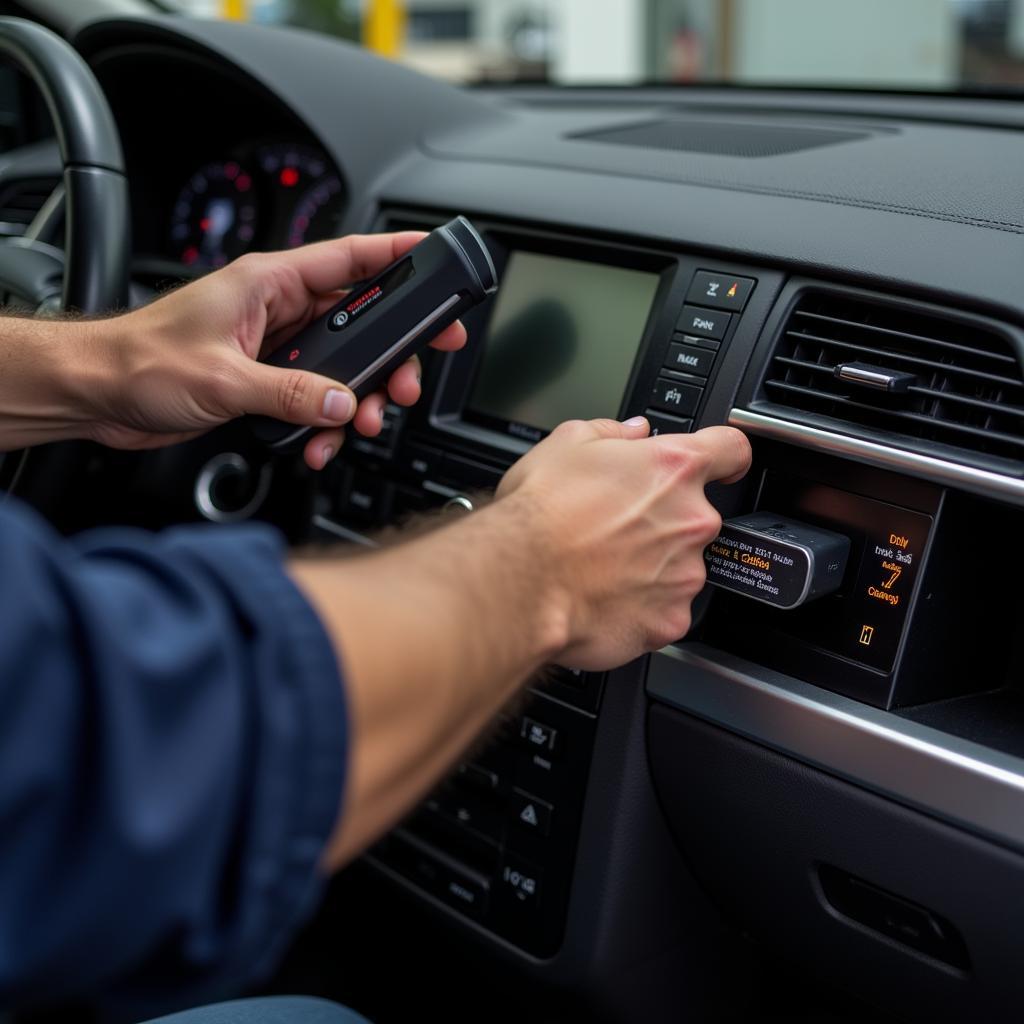The ABS warning light on your Seat Alhambra’s dashboard illuminates when the Anti-lock Braking System (ABS) detects a fault. This system is crucial for your safety, preventing wheel lock-up during sudden braking and allowing you to maintain steering control. This article delves into the common causes behind the Seat Alhambra ABS warning light and provides potential solutions to help you regain control over your vehicle’s safety.
Understanding the ABS System in Your Seat Alhambra
Before we delve into the causes and solutions, let’s briefly understand how the ABS system works in your Seat Alhambra. The system comprises several components:
- Wheel Speed Sensors: These sensors, located at each wheel, constantly monitor wheel speed and relay this information to the ABS control unit.
- ABS Control Unit: This unit processes the data received from the wheel speed sensors. When it detects a wheel about to lock up during braking, it takes over and modulates the brake pressure to that specific wheel, preventing skidding and maintaining steering control.
- Hydraulic Control Unit: This unit, controlled by the ABS control unit, adjusts the brake fluid pressure to each wheel based on the detected conditions.
Common Causes of the Seat Alhambra ABS Warning Light
The ABS warning light can be triggered due to various reasons. Here are some of the most common culprits:
- Faulty Wheel Speed Sensors: One of the most common reasons for the ABS warning light to illuminate is a faulty wheel speed sensor. These sensors can malfunction due to dirt, debris, or even normal wear and tear.
- Damaged ABS Wiring: The wiring connecting the ABS components can become damaged due to corrosion, rodent damage, or general wear and tear.
- Low Brake Fluid Level: Insufficient brake fluid level, often caused by leaks in the brake lines or a worn-out master cylinder, can trigger the ABS warning light.
- Malfunctioning ABS Control Module: In some cases, the ABS control module itself might malfunction due to electrical issues or internal faults.
 Seat Alhambra ABS Sensor
Seat Alhambra ABS Sensor
Diagnosing the Problem
Diagnosing the exact cause of the ABS warning light requires a systematic approach:
- Visual Inspection: Start by checking your Seat Alhambra’s brake fluid level. If it’s low, top it up and inspect for any visible leaks in the brake lines.
- Scanning for Error Codes: If the brake fluid level is adequate, the next step involves retrieving diagnostic trouble codes using an OBD-II scanner. This scanner connects to your car’s onboard computer and reveals specific error codes related to the ABS system, providing valuable insights into the root cause of the problem.
 OBD Scanner Connected to a Seat Alhambra
OBD Scanner Connected to a Seat Alhambra
Potential Solutions for Seat Alhambra ABS Warning Light
The solution to your Seat Alhambra’s ABS warning light depends on the diagnosed problem:
- Replacing Faulty Components: If the diagnosis reveals faulty wheel speed sensors, damaged wiring, or a malfunctioning ABS module, replacing these components is crucial to restore the system’s functionality.
- Addressing Brake Fluid Issues: If low brake fluid level is the culprit, address any leaks in the brake lines or replace the master cylinder if necessary.
- Seeking Professional Help: While some fixes might seem straightforward, seeking professional help from a qualified mechanic experienced with Seat vehicles is highly recommended. They can accurately diagnose the issue, ensuring a safe and effective repair.
Preventing Future ABS Warning Lights
Prevention is always better than cure. Here are some tips to prevent future ABS warning light occurrences:
- Regular Brake Fluid Checks: Regularly check your Seat Alhambra’s brake fluid level and top it up when needed.
- Timely Brake System Inspections: Schedule routine brake system inspections by a qualified mechanic to identify and address potential issues before they escalate.
- Careful Driving Habits: Avoid harsh braking whenever possible to reduce stress on the ABS system and prolong its lifespan.
 Mechanic Inspecting Seat Alhambra Brakes
Mechanic Inspecting Seat Alhambra Brakes
Conclusion
The ABS warning light in your Seat Alhambra is a critical safety indicator that should never be ignored. Understanding the potential causes and solutions can empower you to address the issue promptly and effectively. Remember, a well-maintained ABS system is crucial for your safety and the safety of others on the road. If you’re unsure about diagnosing or fixing the problem yourself, don’t hesitate to seek professional help. For more insights into warning lights on your Seat vehicle, explore our resources on Seat dash warning lights and Seat Alhambra dashboard warning lights. Safe driving!
